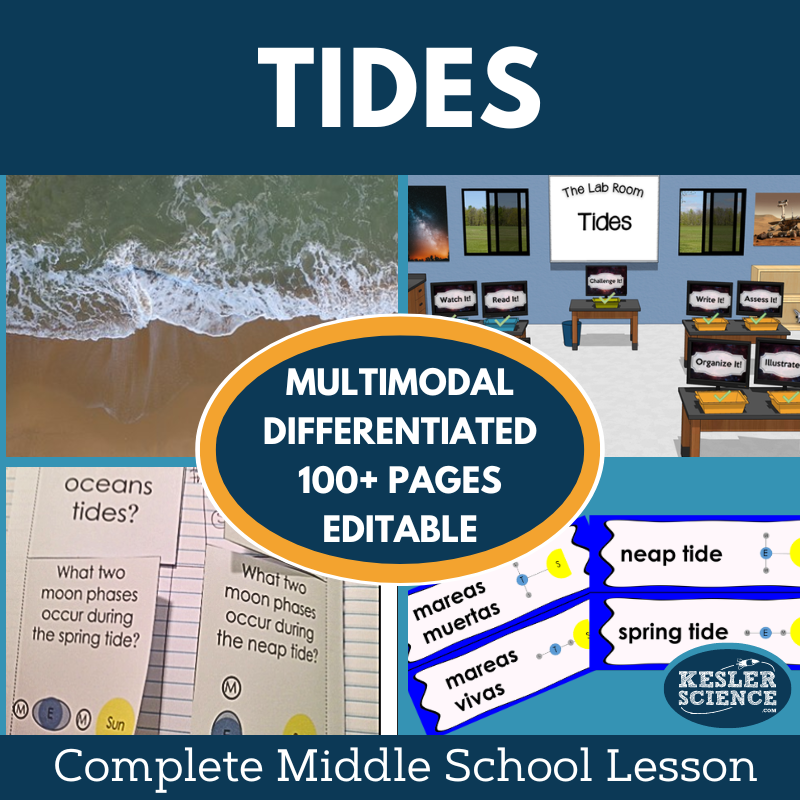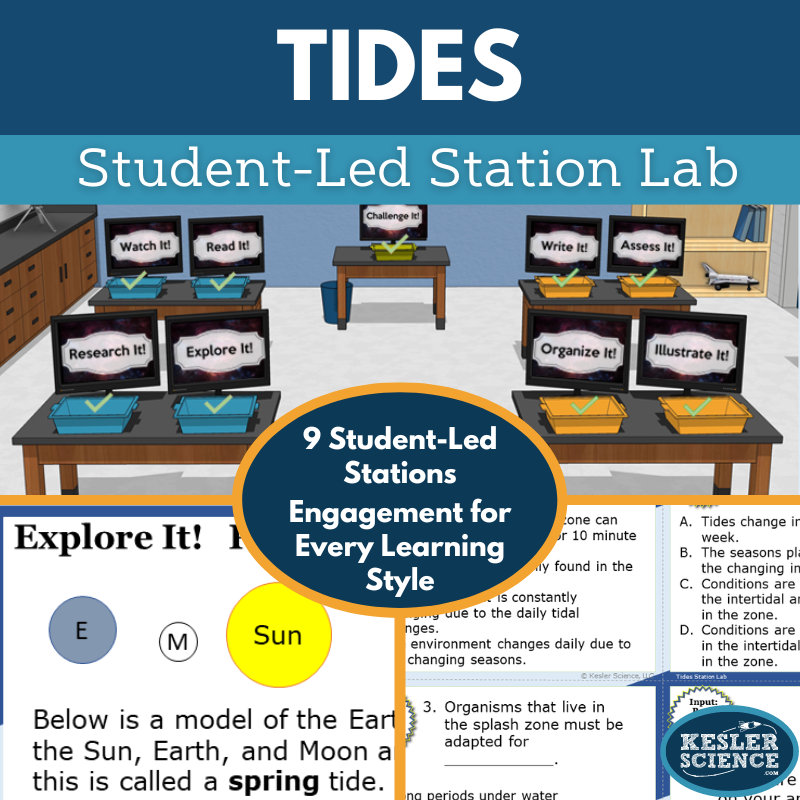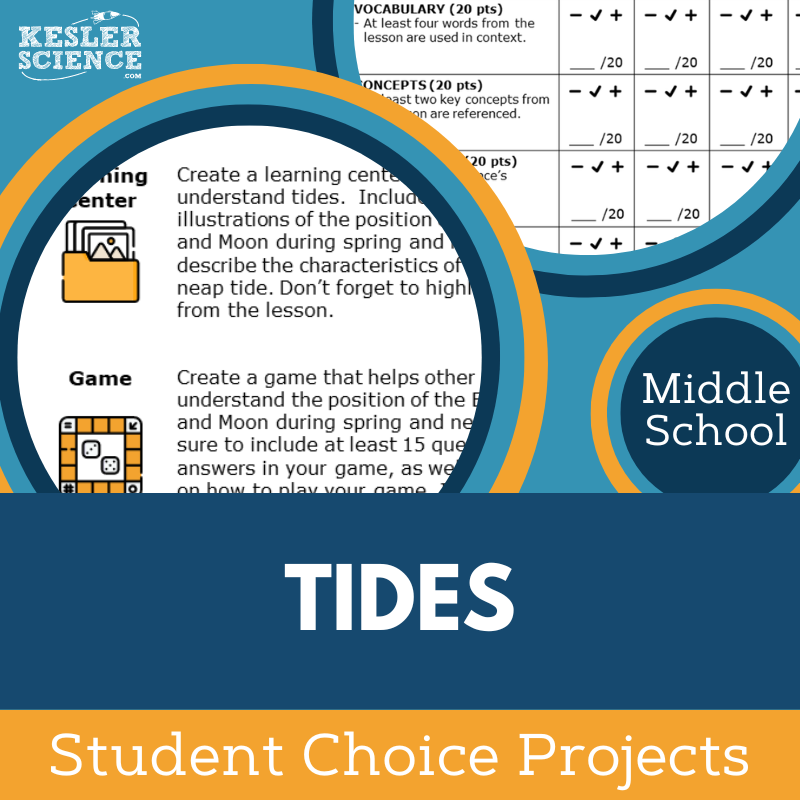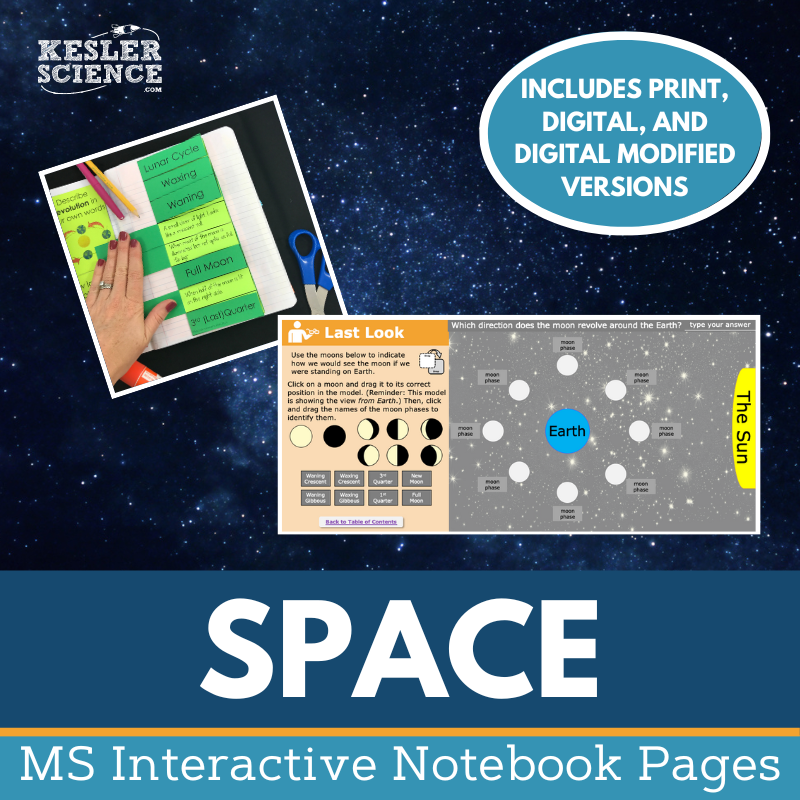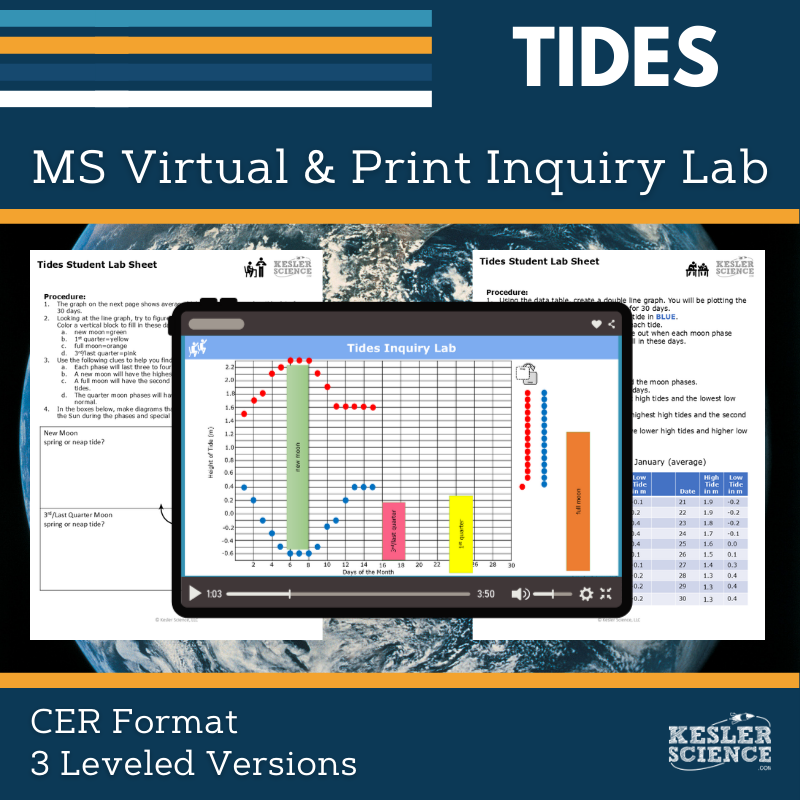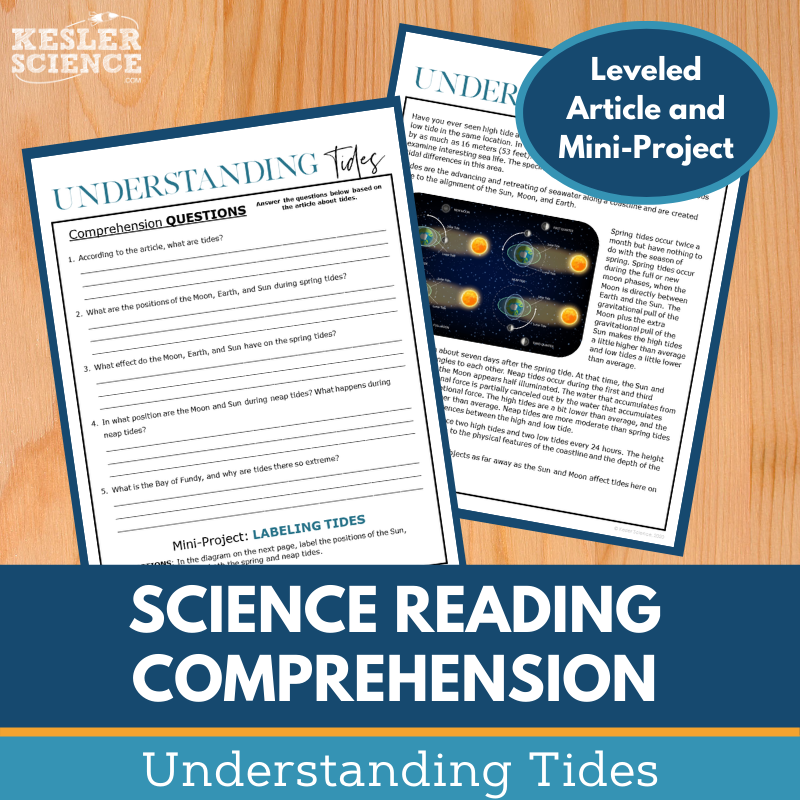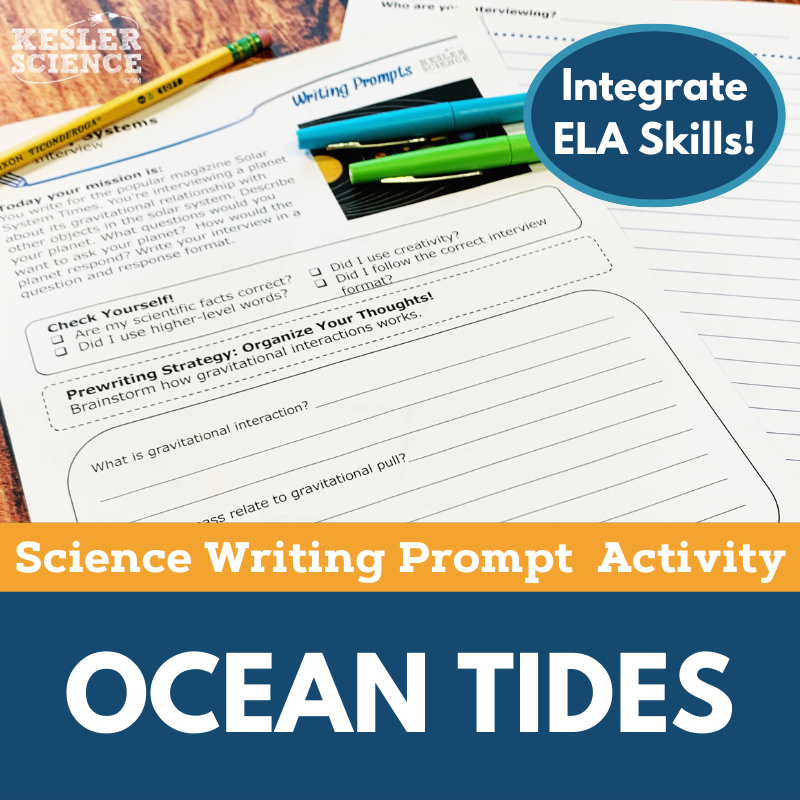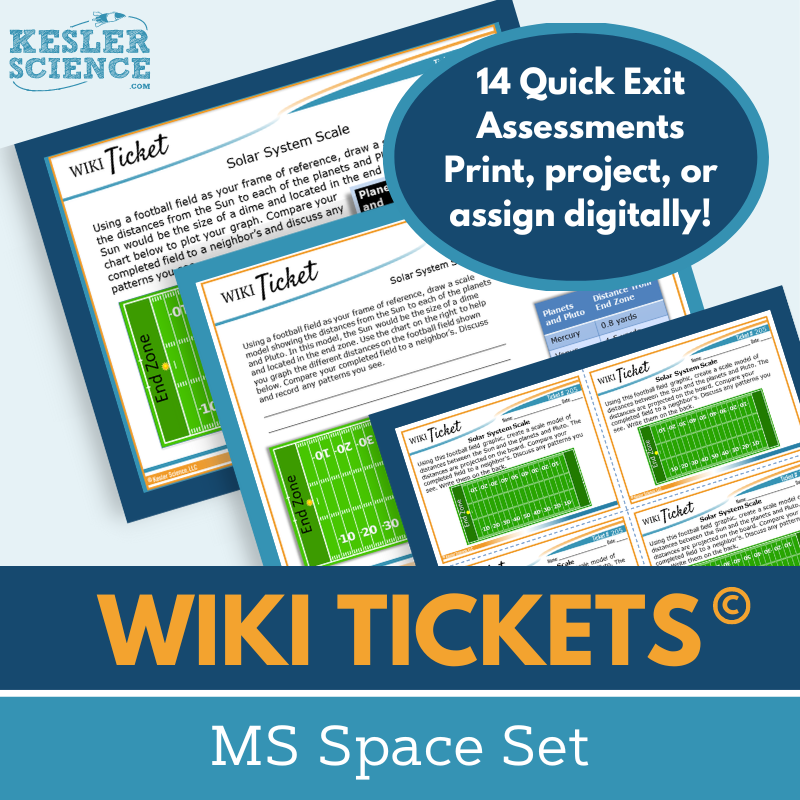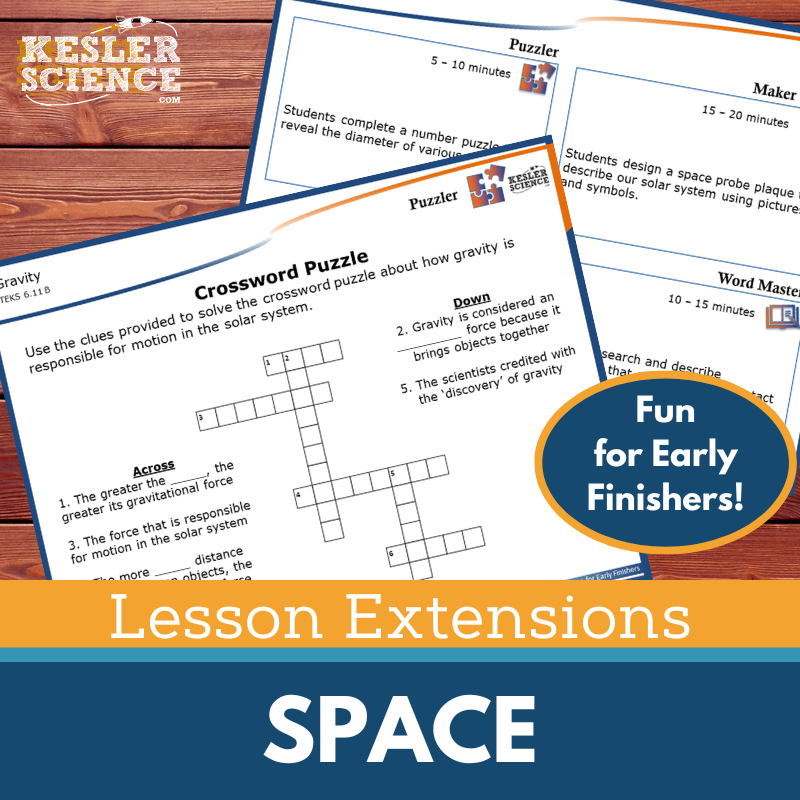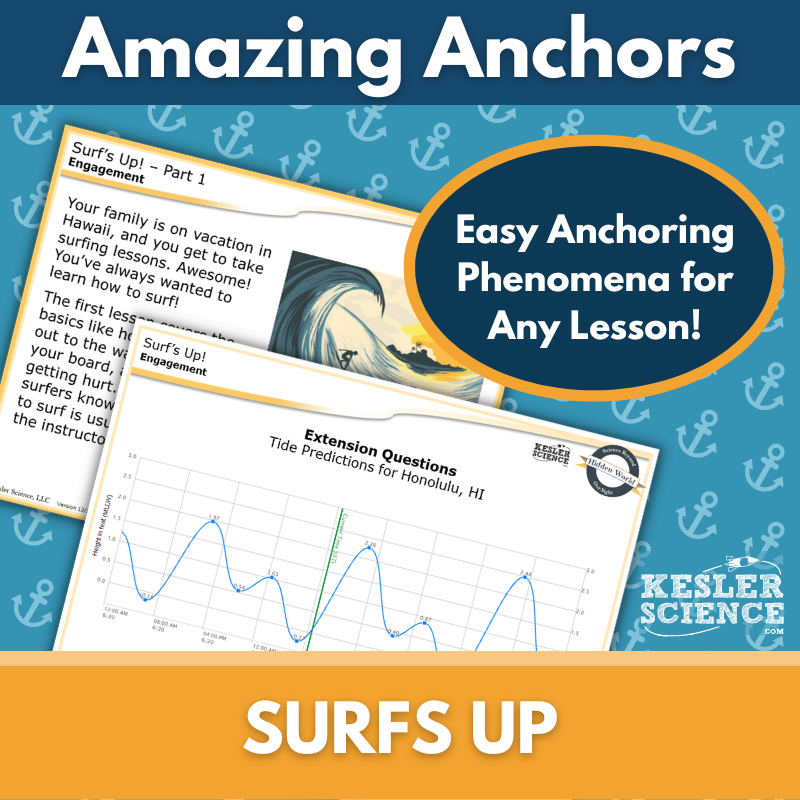Tides Activities for Middle School Science
The Kesler Science Tides Complete 5E Lesson is a dynamic, student-led unit that helps middle schoolers explore how Earth, the Sun, and the Moon interact to create tides. The resources below will give students a comprehensive understanding of tides. All of the following materials are also included in the Kesler Science Membership.
The Kesler Science Tides Complete 5E Lesson offers a comprehensive, student-led unit designed to engage middle schoolers in learning about the effects of Earth, the Sun, and the Moon on tides. This fully editable, multiday unit includes presentations, worksheets, choice projects, and assessments, with minimal prep required for teachers. The lesson is differentiated to meet the needs of all learners and can be used in both in-person and virtual environments.
The lesson follows the 5E model—Engagement, Exploration, Explanation, Elaboration, and Evaluation—ensuring a thorough understanding of tides. During the Exploration phase, students rotate through nine differentiated stations, including hands-on demos, readings, research tasks, and videos. Output stations give students opportunities to demonstrate their understanding through activities like writing, illustrating, and categorizing. The Elaboration phase offers student-choice projects for deeper engagement.
The unit also includes assessments, editable PowerPoints, and interactive notebook templates in English and Spanish, making it adaptable for a variety of learning environments. Challenge stations offer extension activities for early finishers, and differentiated materials ensure support for all students. With flexible formats and a focus on student success, this lesson offers a dynamic and engaging way to learn about tides.
The <Kesler Science Tides Complete 5E Lesson offers a comprehensive, student-led unit designed to engage middle schoolers in learning about the effects of Earth, the Sun, and the Moon on tides. This fully editable, multiday unit includes presentations, worksheets, choice projects, and assessments, with minimal prep required for teachers. The lesson is differentiated to meet the needs of all learners and can be used in both in-person and virtual environments.
The lesson follows the 5E model—Engagement, Exploration, Explanation, Elaboration, and Evaluation—ensuring a thorough understanding of tides. During the Exploration phase, students rotate through nine differentiated stations, including hands-on demos, readings, research tasks, and videos. Output stations give students opportunities to demonstrate their understanding through activities like writing, illustrating, and categorizing. The Elaboration phase offers student-choice projects for deeper engagement.
The unit also includes assessments, editable PowerPoints, and interactive notebook templates in English and Spanish, making it adaptable for a variety of learning environments. Challenge stations offer extension activities for early finishers, and differentiated materials ensure support for all students. With flexible formats and a focus on student success, this lesson offers a dynamic and engaging way to learn about tides.
The Kesler Science Tides Station Lab offers a student-led, modular learning experience that keeps middle schoolers engaged as they explore the relationship between the Moon, the Sun, and ocean tides. This differentiated station lab allows students to guide their own learning, with teachers facilitating the process. Nine stations include hands-on tasks, readings, and multimedia resources to help students understand tidal patterns.
Each station includes both input and output activities to deepen student understanding. Input stations such as "Explore It!" and "Watch It!" engage students through hands-on demonstrations, research tasks, readings, and videos. Output stations like "Illustrate It!" and "Write It!" provide opportunities for students to apply their learning through creative tasks like drawing models, answering questions, and completing activities that demonstrate their knowledge.
The lab also features a Challenge It! station for early finishers, offering extended learning opportunities through games, mini-projects, and crosswords. This flexible resource can be used in both in-person and virtual learning environments, with digital versions available for tasks like manipulating images and text in PowerPoint or Google Slides.
The Kesler Science Tides Station Lab offers a student-led, modular learning experience that keeps middle schoolers engaged as they explore the relationship between the Moon, the Sun, and ocean tides. This differentiated station lab allows students to guide their own learning, with teachers facilitating the process. Nine stations include hands-on tasks, readings, and multimedia resources to help students understand tidal patterns.
Each station includes both input and output activities to deepen student understanding. Input stations such as "Explore It!" and "Watch It!" engage students through hands-on demonstrations, research tasks, readings, and videos. Output stations like "Illustrate It!" and "Write It!" provide opportunities for students to apply their learning through creative tasks like drawing models, answering questions, and completing activities that demonstrate their knowledge.
The lab also features a Challenge It! station for early finishers, offering extended learning opportunities through games, mini-projects, and crosswords. This flexible resource can be used in both in-person and virtual learning environments, with digital versions available for tasks like manipulating images and text in PowerPoint or Google Slides.
The Kesler Science Tides Student Choice Projects offer middle school students the freedom to choose from a variety of project options that best fit their learning style. The lesson provides six student-led project choices along with a "design your own" option. Students can be assessed using an editable rubric that allows teachers, peers, or the students themselves to evaluate their work.
These projects are flexible, allowing teachers to modify the rubric to fit their grading preferences. With multimodal choices, students can demonstrate their understanding in creative ways, catering to different learning preferences and styles.
The lesson includes nine project options, teacher directions, and differentiated versions to support students at various levels. Supplies needed for the projects are minimal and can typically be found in the classroom, with many activities being adaptable for digital completion. Some projects may benefit from crafting supplies for building models.
The Kesler Science Tides Student Choice Projects offer middle school students the freedom to choose from a variety of project options that best fit their learning style. The lesson provides six student-led project choices along with a "design your own" option. Students can be assessed using an editable rubric that allows teachers, peers, or the students themselves to evaluate their work.
These projects are flexible, allowing teachers to modify the rubric to fit their grading preferences. With multimodal choices, students can demonstrate their understanding in creative ways, catering to different learning preferences and styles.
The lesson includes nine project options, teacher directions, and differentiated versions to support students at various levels. Supplies needed for the projects are minimal and can typically be found in the classroom, with many activities being adaptable for digital completion. Some projects may benefit from crafting supplies for building models.
The Kesler Science Space Science Interactive Notebook is an engaging resource for teachers looking to create interactive learning experiences for their students. It includes both print and digital versions, making it perfect for traditional classrooms, 1:1 environments, or distance learning.
The bundle covers key space science topics such as asteroids, meteors, and comets, the Big Bang theory, eclipses, the electromagnetic spectrum, galaxies, and more. The digital version features a PowerPoint interactive notebook, which can be uploaded to Google Slides or learning management systems like MS Teams or Canvas. Reflection pages and space for students to take notes are included, along with a teacher answer key and modified versions for students with accommodations.
The print version provides a full set of blank templates for students, pre-filled templates for those needing modifications, and color photos to illustrate how each template should be used. This bundle is designed to support differentiated learning and keep students engaged in key space science concepts.
The Kesler Science Space Science Interactive Notebook is an engaging resource for teachers looking to create interactive learning experiences for their students. It includes both print and digital versions, making it perfect for traditional classrooms, 1:1 environments, or distance learning.
The bundle covers key space science topics such as asteroids, meteors, and comets, the Big Bang theory, eclipses, the electromagnetic spectrum, galaxies, and more. The digital version features a PowerPoint interactive notebook, which can be uploaded to Google Slides or learning management systems like MS Teams or Canvas. Reflection pages and space for students to take notes are included, along with a teacher answer key and modified versions for students with accommodations.
The print version provides a full set of blank templates for students, pre-filled templates for those needing modifications, and color photos to illustrate how each template should be used. This bundle is designed to support differentiated learning and keep students engaged in key space science concepts.
The Kesler Science Tides Inquiry Lab aligns with NGSS and explores how gravity and inertia affect Earth’s tides. Students will analyze real-world data on high and low tides over a lunar month and connect the patterns to spring and neap tides. Both digital and hands-on print versions guide students through the lab using comprehension questions, C.E.R. writing prompts, and reflection activities.
This lab includes three differentiated versions—Dependent, Modified, and Independent—designed to support a range of learning needs. The Dependent version blends procedures with guided inquiry, the Modified version adds structure with supports like sentence stems, and the Independent version offers a student-led experience with minimal guidance.
Teachers can choose from fully interactive digital labs or printable formats, all of which are editable and compatible with Google Slides. The lab comes with teacher support materials, answer keys, and instructions for setup. The digital format requires no materials, while the print version uses basic classroom supplies like colored pencils and pencils.
The Kesler Science Tides Inquiry Lab aligns with NGSS and explores how gravity and inertia affect Earth’s tides. Students will analyze real-world data on high and low tides over a lunar month and connect the patterns to spring and neap tides. Both digital and hands-on print versions guide students through the lab using comprehension questions, C.E.R. writing prompts, and reflection activities.
This lab includes three differentiated versions—Dependent, Modified, and Independent—designed to support a range of learning needs. The Dependent version blends procedures with guided inquiry, the Modified version adds structure with supports like sentence stems, and the Independent version offers a student-led experience with minimal guidance.
Teachers can choose from fully interactive digital labs or printable formats, all of which are editable and compatible with Google Slides. The lab comes with teacher support materials, answer keys, and instructions for setup. The digital format requires no materials, while the print version uses basic classroom supplies like colored pencils and pencils.
In this engaging middle school science lesson, students explore how the positions of the Moon and Sun influence ocean tides through a leveled nonfiction reading passage. After reading, students answer comprehension questions and complete an activity that involves labeling the positions of the Moon and Sun during different types of tides.
Designed for grades 6–8, the resource includes two articles with Lexile levels between 1100–1300, 5–7 comprehension questions, and a hands-on mini-project. A Cornell notes template is also included to support note-taking. The colorful graphics are printable in grayscale, and materials are provided in both full- and half-page formats for flexible use.
Ideal for distance or in-person learning, this resource can be used with platforms like Google Classroom, MS Teams, Schoology, or Canvas. Students can type directly into the editable files, making them perfect for sub plans, makeup work, ISS, or class-wide instruction. This activity promotes science literacy, textual analysis, and classroom discussion while reinforcing key concepts related to tides.
In this engaging middle school science lesson, students explore how the positions of the Moon and Sun influence ocean tides through a leveled nonfiction reading passage. After reading, students answer comprehension questions and complete an activity that involves labeling the positions of the Moon and Sun during different types of tides.
Designed for grades 6–8, the resource includes two articles with Lexile levels between 1100–1300, 5–7 comprehension questions, and a hands-on mini-project. A Cornell notes template is also included to support note-taking. The colorful graphics are printable in grayscale, and materials are provided in both full- and half-page formats for flexible use.
Ideal for distance or in-person learning, this resource can be used with platforms like Google Classroom, MS Teams, Schoology, or Canvas. Students can type directly into the editable files, making them perfect for sub plans, makeup work, ISS, or class-wide instruction. This activity promotes science literacy, textual analysis, and classroom discussion while reinforcing key concepts related to tides.
The Kesler Science Ocean Tides Writing Prompt Activity engages middle school students in earth science by allowing them to test their knowledge in a creative, student-centered way. The "A Month in the Life" format prompts students to explore ocean tides through a fun, narrative-driven exercise, expanding their science reasoning and writing skills. The activity is designed for easy integration into both in-person and virtual learning environments.
This low-prep, high-quality writing activity includes teacher directions, a comprehensive answer guide, and customizable rubrics. Students receive a full set of materials, including projection-friendly versions, full-sized handouts with pre-writing strategies, and digital interactive options that can be completed remotely. The activity is versatile, with options for differentiation and extension.
Perfect for various classroom uses, the Ocean Tides Science Writing Prompt can serve as a cross-curricular activity, pre-test assessment, student project, or extra credit. It can also be used as make-up work or a differentiation exercise, helping to reinforce key concepts while allowing for individualized student engagement.
The Kesler Science Ocean Tides Writing Prompt Activity engages middle school students in earth science by allowing them to test their knowledge in a creative, student-centered way. The "A Month in the Life" format prompts students to explore ocean tides through a fun, narrative-driven exercise, expanding their science reasoning and writing skills. The activity is designed for easy integration into both in-person and virtual learning environments.
This low-prep, high-quality writing activity includes teacher directions, a comprehensive answer guide, and customizable rubrics. Students receive a full set of materials, including projection-friendly versions, full-sized handouts with pre-writing strategies, and digital interactive options that can be completed remotely. The activity is versatile, with options for differentiation and extension.
Perfect for various classroom uses, the Ocean Tides Science Writing Prompt can serve as a cross-curricular activity, pre-test assessment, student project, or extra credit. It can also be used as make-up work or a differentiation exercise, helping to reinforce key concepts while allowing for individualized student engagement.
The Kesler Science Space WIKI Tickets are engaging formative assessments designed for 6th-8th grade science topics, offering multiple flexible formats to check student understanding. Each topic in the Space Set includes five versions: full-screen display, three handout sizes (full, split, and quarter-page), and a digital interactive option that can be used as an editable PowerPoint or Google Slides file.
These assessments are aligned with NGSS and TEKS middle school science standards, with some topics featuring multiple tickets. Each set also includes a bonus table of contents file to show standard alignment, ensuring a comprehensive understanding of the covered topics.
Perfect for both in-class and remote learning, WIKI Tickets can be used as exit tickets, bellringers, or anytime you need to gauge students' progress. Whether projected on a screen or completed digitally, these colorful and engaging assessments provide valuable insight into student comprehension of key space science topics such as the lunar cycle, solar system properties, and space exploration.
The Kesler Science Space WIKI Tickets are engaging formative assessments designed for 6th-8th grade science topics, offering multiple flexible formats to check student understanding. Each topic in the Space Set includes five versions: full-screen display, three handout sizes (full, split, and quarter-page), and a digital interactive option that can be used as an editable PowerPoint or Google Slides file.
These assessments are aligned with NGSS and TEKS middle school science standards, with some topics featuring multiple tickets. Each set also includes a bonus table of contents file to show standard alignment, ensuring a comprehensive understanding of the covered topics.
Perfect for both in-class and remote learning, WIKI Tickets can be used as exit tickets, bellringers, or anytime you need to gauge students' progress. Whether projected on a screen or completed digitally, these colorful and engaging assessments provide valuable insight into student comprehension of key space science topics such as the lunar cycle, solar system properties, and space exploration.
The Kesler Science Space Lesson Extensions provide engaging activities designed to challenge fast finishers and deepen student learning. These critical thinking tasks are connected to NGSS and TEKS space standards, offering rigorous but fun opportunities to explore topics in greater depth. With activities like puzzles, hands-on maker space tasks, tech connections, and creative word writing, these extensions promote STEAM skills and digital literacy.
The Lesson Extensions are structured to provide flexible support for teachers, with clear directions, answer keys, and both digital and paper versions. These materials help reinforce the lesson’s core concepts while offering ways to engage students during testing or other gaps in the schedule.
Perfect for independent learners, these activities push students to apply their knowledge creatively while connecting it to real-world applications. The extensions cover a variety of space science topics, including gravity, space travel, and the lunar cycle, providing additional challenges that extend the learning experience beyond the standard lesson.
The Kesler Science Space Lesson Extensions provide engaging activities designed to challenge fast finishers and deepen student learning. These critical thinking tasks are connected to NGSS and TEKS space standards, offering rigorous but fun opportunities to explore topics in greater depth. With activities like puzzles, hands-on maker space tasks, tech connections, and creative word writing, these extensions promote STEAM skills and digital literacy.
The Lesson Extensions are structured to provide flexible support for teachers, with clear directions, answer keys, and both digital and paper versions. These materials help reinforce the lesson’s core concepts while offering ways to engage students during testing or other gaps in the schedule.
Perfect for independent learners, these activities push students to apply their knowledge creatively while connecting it to real-world applications. The extensions cover a variety of space science topics, including gravity, space travel, and the lunar cycle, providing additional challenges that extend the learning experience beyond the standard lesson.
This Amazing Anchors Phenomenon Lesson introduces ocean tides through the real-world context of surfing in Hawaii. Students begin with an engaging reading that explores how tides affect surfers, followed by comprehension and extension questions to activate prior knowledge. The second reading explains how the gravitational pull between the Moon, the Sun and Earth creates tides, helping students deepen their scientific understanding through additional comprehension and reinforcement questions.
Designed to support any middle school lesson on tides, this TEKS-aligned resource includes teacher directions with answer keys, full-page projection slides, editable PowerPoint files, and printable half- and full-sheet handouts for student notebooks. Both print and digital formats are available, making it easy to incorporate into classroom or virtual settings.
To support diverse learners, the lesson includes differentiated materials with a modified version offering sentence starters and simplified language. These bookend readings are ideal for the Engage and Elaborate phases of the 5E Model and work as a powerful supplement to any existing lesson on ocean tides.
This Amazing Anchors Phenomenon Lesson introduces ocean tides through the real-world context of surfing in Hawaii. Students begin with an engaging reading that explores how tides affect surfers, followed by comprehension and extension questions to activate prior knowledge. The second reading explains how the gravitational pull between the Moon, the Sun, and Earth creates tides, helping students deepen their scientific understanding through additional comprehension and reinforcement questions.
Designed to support any middle school lesson on tides, this TEKS-aligned resource includes teacher directions with answer keys, full-page projection slides, editable PowerPoint files, and printable half- and full-sheet handouts for student notebooks. Both print and digital formats are available, making it easy to incorporate into classroom or virtual settings.
To support diverse learners, the lesson includes differentiated materials with a modified version offering sentence starters and simplified language. These bookend readings are ideal for the Engage and Elaborate phases of the 5E Model and work as a powerful supplement to any existing lesson on ocean tides.
Year-Round Resources
These year-round activities will increase your students' understanding of many middle school science topics. All of these activities are also included in the Kesler Science Membership.
Visual Data & Graphing
You're not alone if your students struggle with understanding graphs, charts, and tables. It's a skill that takes an enormous amount of practice. This resource will help students build a strong foundation in analyzing data and creating their own data visualizations.
Bell Ringers and Warm-Ups
These middle school science bell ringers are an excellent way to engage your students as soon as they walk into your classroom. This comprehensive FULL YEAR resource includes everything you need to start off each science class with an interesting warm-up activity.
Review Board Games
Each game board has been carefully designed to keep students engaged. There are 10 different action spaces on each board and dozens of question cards. All of the actions are related to science concepts and keep the students motivated throughout the game.
Each game is ready to play. Simply print out the board and the cards and let the students enjoy reviewing nine different units.
Essential Questions
Below are the essential questions associated with the lessons and activities included in this unit. This topic is only one of more than 100 middle school science topics included in the Kesler Science Membership.
-
Can you describe how the position of the Sun, Earth, and Moon affect the tides?
-
Can you describe the characteristics of spring and neap tides?
Kesler Science Membership
Imagine never having to search for another middle school science lesson again. The membership gives you access to ALL of the Kesler Science products in one place (Yes, including everything above).
Say goodbye to long hours of lesson prep.

